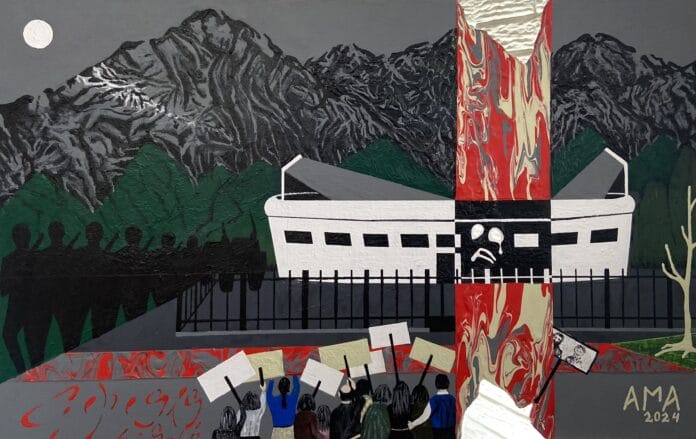Fred Ama, a visual artist, has built his career at the intersection of intellectual rigor and creative exploration. His academic achievements reflect a deep curiosity and commitment to expanding the understanding of both art and human knowledge.
He holds a Master’s Degree in Philosophy of Science (USACH, 2009) with the highest distinction and a Master’s in Business Administration (USACH, 2003). His philosophical training gave him tools to question reality, representation, and perception, questions that directly inform his artistic practice.
In addition, his commitment to art education has been rigorous and continuous. He pursued diplomas in Art History (PUCV, 2025), Aesthetics and Philosophy (Catholic University of Chile, 2024), and extensive studies in fine arts at the Pontifical Catholic University of Chile. Between 2013 and 2017, he immersed himself in painting, drawing, general art, and visual theory. Each layer of study added nuance to his creative vision, allowing him to approach painting not just as an expressive medium but as a dialogue with history, philosophy, and society.
Intellectual Curiosity Meets Artistic Practice
Fred’s work is deeply influenced by the historic avant-garde movements of Europe and the groundbreaking evolution of Abstract Expressionism in New York. These artistic revolutions, which challenged conventional notions of image-making and expanded the frontiers of visual language, continue to fascinate him.
For Fred, art is not merely an act of representation; it is a search for change, an attempt to participate in what he calls the construction of the future image. This perspective reflects both his philosophical training and his passion for visual experimentation. His practice is driven by questions: What kind of painting will emerge? What kind of images could expand the boundaries of visuality?
This sense of inquiry and forward-looking energy is what gives his work both its intellectual rigor and its emotional urgency.
Lifelong Learning and Global Engagement
Fred Ama’s pursuit of knowledge extends beyond traditional academia. In 2024, he participated in the Teaching Critical Thinking through Art program with the National Gallery of Art, offered by SmithsonianX, an initiative of the Smithsonian Institution. This course reinforced his belief in the power of art as a tool not only for aesthetic engagement but also for critical dialogue.
In 2023, he completed five certificate courses with Coursera and the Museum of Modern Art (MoMA), covering themes from Modern Art and Ideas to Fashion as Design, Seeing Through Photographs, and Modern and Contemporary Art and Design. These experiences enriched his artistic perspective, situating his work within a global conversation about art’s evolving role in society.
Artistic Vision: Expanding the Boundaries of Visuality
Fred Ama’s art is not confined to the reproduction of images; it is an act of re-creation and reflection. By drawing on philosophy, history, and aesthetics, his work challenges viewers to confront uncomfortable truths while imagining new possibilities for visual culture.
He is particularly inspired by the idea of fragmentation, the notion that history, memory, and visual representation are not seamless wholes but fractured narratives. This theme plays a central role in one of his most important recent works.
Artwork Highlight: National Stadium (2024)
One of Fred Ama’s most poignant pieces is the painting National Stadium (2024), an acrylic on canvas that reflects on Chile’s turbulent history. The work commemorates the 50th anniversary of the atrocities committed in Chile’s National Stadium following the military coup of 1973.
During this dark chapter, the stadium became a site of imprisonment, torture, and brutality, echoing the violence and repression that marked many South American dictatorships of the era. Thousands of victims were detained, their lives fragmented by state-sponsored terror.
In National Stadium, Fred uses visual fragmentation as both form and metaphor. The canvas is deliberately broken into pieces, symbolizing the fractured history of Latin America and the deep wounds left in the national conscience. The imagery acts as both a memorial and a warning, a reminder that the scars of violence linger long after the events themselves.
Fred describes the painting as a claw tearing open a wound in collective memory. Through this work, he seeks not only to honor the victims but also to provoke reflection about the importance of historical memory in shaping more just futures.
Philosophy in Action: Art as Memory and Transformation
Fred Ama’s artistic philosophy is inseparable from his intellectual training. His grounding in philosophy of science drives him to think about systems, structures, and paradigms, while his studies in aesthetics sharpen his understanding of how images create meaning.
In his hands, painting becomes a form of critical inquiry, a way to expose the fractures of history, interrogate the present, and imagine future possibilities. Works like National Stadium are not passive depictions of events but active interventions, urging audiences to remember, question, and transform.
Conclusion: Toward the Future Image
Fred Ama stands at the intersection of philosophy, history, and visual art. His intellectual achievements and artistic explorations feed one another, producing work that is both conceptually rigorous and emotionally resonant.
As he continues to pursue his vision of the future image, Fred reminds us that art is more than aesthetic pleasure; it is a tool of memory, transformation, and renewal. His commitment to expanding the boundaries of visuality ensures that his practice will not only reflect the past but also help construct the visual culture of tomorrow.


